| | Introduction | Storage and conditioning | Appropriate conditions for storage | Conditioning processes | Drying temperatures | Solar drying | Types of grain dryers | Storage facilities | Heating of stored grain | Factors contributing to storage problems | Detecting infestations | Controlling infestations
Adapted from the Canada Grain Council's Complete Guide to Wheat Management.
Introduction
Once a cereal crop is harvested, it may have to be stored for a period of time before it can be marketed or used as feed or seed. The length of time cereal can be safely stored will depend on the condition it was harvested and the type of storage facility being utilized. Grain binned at lower temperatures and moisture contents can be kept in storage for longer periods of time before its quality will deteriorate. The presence and build up of insects, mites, molds and fungi, which are all affected by grain temperature and grain moisture content, will affect the grain quality and duration of grain storage.
Storage and Conditioning of Grain
Conditioning of grain has the single purpose of preserving the quality of grain. Low moisture content and low temperature have been shown to be essential for successful storage of grain for a long period of time. A number of processes are available for conditioning of grain thereby ensuring safe storage.
Appropriate Conditions for Storage
Proper conditions to store grain effectively are those which prevent or discourage the growth of microorganisms and insects. Such conditions involve control and maintenance of:
- Moisture content of grain
- Temperature of the grain
- Condition and soundness of the grain
- Oxygen supply of the storing environment.
Conditioning Processes of Cereal Grain
Advantages of conditioning (drying)
- Allows for harvesting tough grain and thereby reduces losses from weather and wildlife.
- Extends available harvest period.
- Earlier harvest is possible.
- Drying tough or damp grain can reduce or eliminate spoilage in storage.
- May improve market grade and acceptability of grain.
- May afford alternative market outlets for grain.
- May eliminate necessity of swathing to obtain "dry" grain.
- May improve malting quality by reducing kernel peeling and cracking during combining. However, most maltsers will not knowingly buy grain which has been artificially dried.
- Since artificially dried grain usually contains near maximum allowable water content, the extra weight generates more dollars when sold.
Disadvantages of conditioning (drying)
- Requires extra capital for equipment, energy and operation.
- Requires extra labor and inconvenience of handling unless centralized facilities are available.
- Requires some experience to operate effectively.
- May impair quality of malting barley if not operated properly (low air temperature).
Aeration
Aeration is the process of ventilating stored grain at low air flow rates with the purpose of maintaining a fairly uniform grain temperature throughout the bin to prevent moisture accumulation at the top (or bottom] layers of the bin due to natural convection. The amount of air required to change the temperature of the grain may not change the moisture content very much. Although aeration is not a grain drying system and should not be considered as such, some drying can occur when the weather is very dry and the fan is run for a very long time. Moreover, the low airflows (1-2 litres/second/cubic metre) used are not sufficient for reliable safe storage unless grain temperatures are near or below 0 °C
Unheated or natural grain drying
In this system, the drying potential of surrounding air is utilized to remove moisture from the grain. It has been viewed as a race to get the grain dried before it spoils. Normally air is forced into the bin from the bottom through a fully perforated floor and exhausted through the roof vents. The moisture transfer from the grain to air takes place in the drying zone (Figure 1).
. 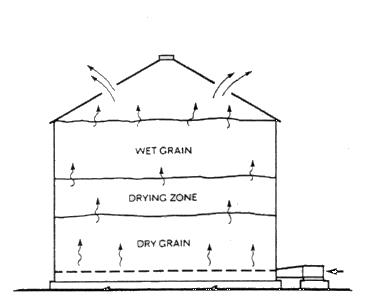
Figure 1. Unheated air drying
The key to success is to move the drying zone through the top of the grain mass within the allowable storage time. As shown in Figure 2, the allowable time for drying is reduced at high grain temperature and moisture content. This means a higher airflow requirement to accomplish drying within the allowable storage for wetter grain. Similarly at higher temperatures, high airflow rates are required to complete drying before grain spoils.
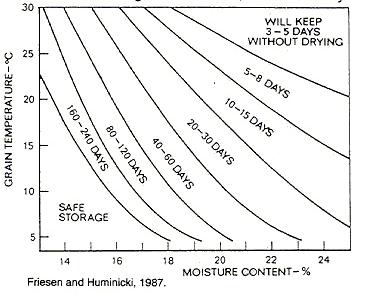
Figure 2. Effect of temperature and moisture content on allowable storage time of wheat, oats, and barley.
Dryeration
Dryeration is a modification of the system that utilizes heated air drying followed by rapid cooling of the grain in the dryer before transferring to storage. In dryeration, the hot grain is transferred to a cooling or dryeration bin. There it is tempered (stored without airflow) for 8 to 10 hours before being slowly cooled. The grain may be transferred to another bin for storage.There are three advantages with dryeration over heated air drying with in-dryer cooling:
- Improved energy efficiencies
- Less danger of grain quality reduction
- Increased drying capacity due to higher drying temperature and replacement of the cooling section by an additional drying section.
In-storage cooling
The differences between in-storage cooling and dryeration is that when the hot grain is delivered from the dryer to a cooling bin with a partially perforated floor, the fan is started immediately rather than allowing the grain to temper. Tempering is eliminated in order to reduce or eliminate the condensation on the roof and walls. This allows the grain to be stored in the cooling bin rather than being transferred to another bin for storage. In-storage cooling may be an attractive alternative for bins with partially perforated floors, since it allows them to be used for both cooling and final storage.
Heated air grain drying
Whenever aeration or natural air drying fails to adequately condition grain for storage, a heated air dryer may be incorporated into the harvesting storage system. Compared to natural air drying, the heated air drying absorbs more moisture from the grain thus drying the grain faster. Over drying of a cereal grain however, reduces the weight of grain that will be sold as less water is being sold. Also, it is more expensive in terms of propane costs. These costs must be balanced against how long the wheat has to be safely stored and under what storage conditions.
Drying Temperatures
Some factors as listed below may dictate the maximum temperatures for drying cereal grain:
- length of storage
- low temperatures should be used if the grain is to be stored for 6 months or more.
- moisture content
- the damper the grain, the longer the drying process. Low temperatures should be used.
- type of grain dryer
- lower temperatures should be used in dryers which do not mix or circulate the grain.
- end use of the grain - malt or seed - low temperature
Maximum safe air temperatures entering dryer for barley and wheat
Because excessive heat can damage cereal grain and reduce their ability to germinate, maximum safe air temperatures must not be exceeded.
 | Seeding and Malting | Commercial | Feed |
Barley | 45 Degrees Celsius (113 Degrees Fahrenheit) | 55 Degrees Celsius (131 Degrees Fahrenheit) | 80-100 Degrees Celsius (176-212 Degrees Fahrenheit) |
Wheat | 60 Degrees Celsius (140 Degrees Fahrenheit) | 65 Degrees Celsius (149 Degrees Fahrenheit) | 80-100 Degrees Celsius (176-212 Degrees Fahrenheit) |
Solar Drying
Spreading out a thin layer of grain in the sun is a form of solar drying that has been practiced for many years all over the world and is still being carried out in many tropical countries. However the disadvantages of this system are:
- Uncertainty of success due to variable weather
- Non uniform grain quality.
To circumvent these problems associated with traditional sun drying while still directly using the energy emitted by the sun, solar collectors have been applied in conjunction with a fan, a duct system and a bin in which grain is dried and stored.
Solar grain drying has been investigated in Alberta as one alternative to grain drying but has not proved to be dependable.
This has been attributed to the high cost of collectors and the unreliable sunshine when it is needed for drying. The conclusion has been that in Alberta, both hot air and natural air grain drying are more appropriate than solar grain drying.
The design of solar grain dryers cannot be as precise as for other types of driers because of the diffuse, intermittent and unpredictable nature of solar energy.
Types of Grain Dryers
Major types of hot air dryers are designed as:
- Bin
- Batch
- Continuous flow
Bin
The basic system of a bin dryer comprises of a fully perforated floor, a grain spreader, fan and heater, sweep auger and under floor unloading auger. In this system, grain is loaded as a batch and remains stationary in the dryer throughout the drying period. Advantages of bin dryers are: Low set up cost.
- Minimal supervision required.
- Availability of bin for storage after drying is completed.
- Possibility of obtaining variable batch sizes.
Disadvantages of bin dryers are:
- Initial high cost normally including grain handling.
- Requirement of careful management in order to obtain acceptable uniform drying.
- Requirement of matching loading and unloading equipment.
Batch dryers
The batch dryers are designed as:
- Non recirculating
- Recirculating
In the non-recirculating system, the column of grain is kept in the same position relative to the drying air for complete batch drying. The grain is under dried on the outside and over dried on the inside layer. The final moisture content of the grain is the average of the mixture when it is emptied. This problem is alleviated by the recirculating batch dryer in which grain is mixed constantly while drying using a recirculating auger. The advantages/disadvantages of batch dryers are:
- Uniformly dried grain due to constant recirculation in the recirculation type.
- Supervision required.
- Loss in drying time while the batch is being loaded or unloaded.
Continuous flow dryers
In these systems, hot air is passed through a continuously flowing mass of grain. After the hot air, cool air is blown through the grain. Because the grain passes the drying column only once, grain is often not dried as uniformly as the recirculating batch dryers. Advantages of continuous flow dryers is:
- Large quantities of grain can be dried without stopping.
Disadvantages of continuous flow dryers are:
- Initial high cost normally including grain handling.
- Requirement of careful management in order to obtain acceptable uniform drying.
- Requirement of matching loading and unloading equipment.
Storage Facilities
Storage facilities are intended to:
- Prevent losses due to leakages, rodents, and livestock;Requirement of a central location.
- Protect grain from damage due to moisture migration, snow, rainfall, heating, insects and molds;
- Provide easy access with regards to handling or inspecting of grain.
The best storage facilities are those that are weather proof, ventilated and of single wall construction. Because small bulks cool faster and more evenly than large bulks, it is better to have several smaller bins than a few larger, ones, especially when aeration equipment is not available. Storage structures may be made of metal or wood and regardless of the nature, they all have advantages and disadvantages. They should be built on high, well drained land in order to protect grain from heavy rainfall and spring floods. Occasionally when the crop yields are above average, grain is stored in temporary storage including barns, machine sheds or in an open area.
Metal structures
Metal storage structures range in shape from circular steel bins and arch-roof types to slant and straight wall rectangular units.
Circular bins are the most common on the Canadian prairies because they are easy to erect, easy to maintain, come in a wide range of sizes and are adaptable to mechanized unloading, aeration and drying systems.
Advantages of metal structures are:
- Fire proof
- Rodent proof
- Require little or no maintenance, strong
- Provide fewer places for insects to breed
- Infested grain can be fumigated more effectively
Disadvantages of metal structures include:
- When erection on reinforced concrete slabs these slabs sometimes crack and allow ground moisture to seep into the grain.
- Expansion of storage sides when filled with grain, requiring waterproofing of the open seams.
Wood structures
The wood bins can be rectangular, circular or arch roof structures. Rectangular wood bins may be of either frame or crib construction. Grain unloading can be partially mechanized. Arch-roof structures may be either glulam curved arch or gambrel roof arch. Mechanized unloading can be included but it is not as convenient as with a circular storage. However, arch-roof structures may be used as machinery storage when not required for grain.
Advantages of wood structures:
- most of them are small, therefore can be moved when empty.
Disadvantages of wood structures:
- Require frequent repairs to keep weatherproof
- Not fire proof
- Not as rodent proof as metal
- The many cracks in wood makes it difficult to effectively control insects.
Temporary storage
As mentioned earlier, when there is a shortage of space because of above average yields and buying more bins is not possible, temporary storage may be the next best thing to seek the following are possible emergency or temporary grain storage facilities:
- Open piles.
- Covered piles and suction fans
- Plastic Ag storage bags
- Snow fencing and paper
- Woven wire bins
- Plank bins
- Baled straw or hay and wire ties
- Temporary plywood bins
- Commercially available temporary storages
- Existing farm buildings
Fill the bins to the brim to avoid free board between the grain and upper lip of the bin. Free-board space holds snow. Use a dark polyethylene shut to cover dry grain but leave tough and damp grain uncovered to dry by exposure to wind and sunshine.
In emergencies, cereal grain may be stored for short periods in conial piles on the ground. Cone the grain as high as possible in the centre of the pile without disturbing the natural slope of the sides and protect is from all disturbances.
No matter what type of structure is used to store grain, the filling should be done in the centre as this will provide even loading of the walls and a smooth uniform cone to help shed rain.
Fill the granary only to the top plate to provide crawl spaces for inspection, and for ventilation. Never store newly harvested grain on top of old grain that may be infested with insects or contain spoiled grain.
A survey conducted by Friesen (1972) indicated that wood was by far the most commonly used structure in bin construction in the three prairie provinces. Today bins are almost exclusively of metal construction and are becoming larger and equipped with natural air drying equipment.
Heating of Stored Grain
Stored grain is or can be at risk from damage that results from heating. The heating results from grain respiration, as well as respiration from microorganisms, insects, and mites during storage. The resulting heat from respiration can lead to the development of hot spots within the grain. The higher the moisture content and temperature of grain at storage time, the greater the risk of hot spots. A vicious circle of heating can be established leading to greater respiration resulting in the release of yet more heat causing increased temperature which in turn stimulates greater activity and so on. Continuous production of heat may lead to temperatures high enough to kill microorganisms, thus leaving heating due to oxidation (burning without flame).At temperatures of 50°C (122 °F) oxidation increases temperature so rapidly that if left uncontrolled, spontaneous combustion could occur within a short period. While this is the extreme effect of heating, it can also result in loss of ability to germinate as well as poor grain quality.
Thus heating of seed can result in:
- Loss in ability to germinate.
- Loss in weight
- Reduced quality
- Burning (in extreme conditions).
Table 2 shows the maximum moisture content levels at which cereal, pulse, and oilseed can be sold as straight grade, as permitted under the Canada Grain Act. The levels are revised periodically. If seed is sold as straight grade and the moisture content levels exceed the values shown in Table 2, a penalty is charged. The amount of the penalty is determined by the amount of moisture content above the acceptable level. Because seed with the moisture content levels shown in Table 2 can be sold without penalty, such values are often assumed to represent safe levels. In practice, though, the safe moisture content levels are one or two percentage points below those given in Table 2.
Table 2 Maximum moisture content levels for straight grade seeds*.
| Barley (feed) | 14.8 |
| Barley (malt) | 13.5 |
| Canola rape seed | 10.0 |
| Corn/maize | 15.5 |
| Domestic buckwheat | 16.0 |
| Domestic mustard seed | 10.0 |
| Fababeans | 16.0 |
| Flax | 10.0 |
| Lentils | 14.0 |
| Oats | 13.5 |
| Peas | 16.0 |
| Rye | 14.0 |
| Safflower | 9.5 |
| Soybean | 14.0 |
| Sunflower | 9.5 |
| Triticale | 14.0 |
| Wheat | 14.5 |
*Percentage wet weight basis
Factors Contributing to Storage Problems
Regardless of whether the grain moisture content and temperature have been determined and rated as safe, problems may yet occur. The relationships between moisture and temperature can dictate the severity of the problem (Figure 2). Safe storage time can be increased by cooling the grain and lowering its moisture content. If the grain has been stored in a "tough" condition [greater than 14.8% ( feed barley), 14.5% (wheat), 14.0% (triticale and oats) moisture] examine the grain at least every two weeks by pushing your hand into the surface, as deeply as possible, to feel for warmth or crusting. Insert a long metal rod deeply into the grain to test for warmth and crusting at various depth. Feel the rod for warmth as soon as the rod is withdrawn from the grain. Additional factors may contribute to grain heating and deterioration in only localized parts of the bin.
Moisture migration
At the time grain is first stored, grain moisture content is fairly uniform throughout the bin. With time, localized high moisture zones may develop due to changes in outdoor air temperatures. The low outside temperature cools the wheat nearer the wall. This results in a downward air flow through the grain and upward towards the centre of the bin. As the air moves through the grain it becomes warmer and begins to pick up moisture from the grain. Condensation occurs when the warm moist air hits the cool surface of the grain near the centre of the bin, thus leading to grain spoilage Figure 3.
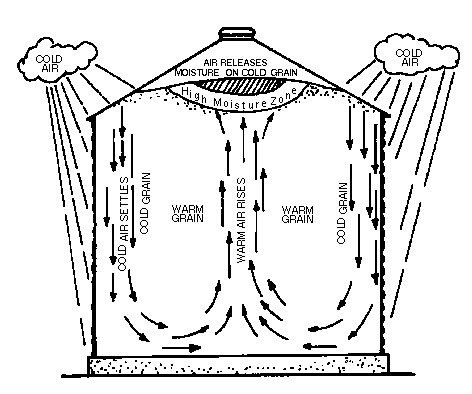
Figure 3. Moisture migration in storage bin in cold weather
The reverse airflow may occur if grain is still in storage in the late spring. Warming action from the sun on the outside of the bin causes moisture currents to move up and into the bin through the centre of the bin. High moisture due to condensation therefore occurs at the bottom of the bin in Figure 4. In addition, wet zones may form in the grain when rain or snow gets into the storage through ventilators and cracks in the roofs and walls.
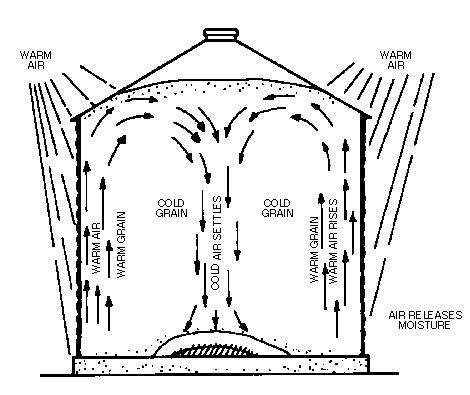
Figure 4. Moisture migration in storage bin in warm weather.
Insects, mites and molds
Failing to protect grain from infestations may result in quality losses; a price that may be too high to pay. The insects, mites and molds that cause grain to heat and lose condition are inactive at low temperatures (below 8 °C (48.4 °F) for insects, 3°C (37.4°F) for mites and 8°C (17.6 °F) for molds). Moisture content of grain below 13% arrests the growth of most molds and mites. Moisture content below 10% limits the development of most stored grain insects and pests. In addition to actual moisture content of the grain, bulk of grain stored also affects the rate of cooling. Tough (moisture content 14.6%-17.0 %) and damp (moisture content> I 7.0 %) grain stored in bulks of less than 27 tonnes usually cools rapidly and evenly during winter. However a bulk larger than 50 metric tonnes or more cools more slowly, hence temperature differences between the centre may cause condensation and spoilage.
Practical farm storage conditions are summarized in Figure 5. The ideal condition would be a moisture content of 12% or less and a temperature of 3 °C or less.
.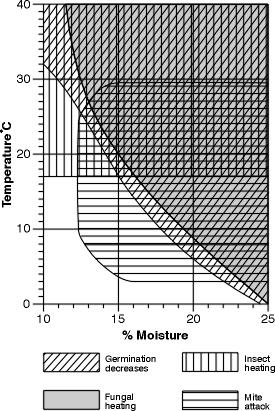
Figure 5. Practical farm storage conditions
Detecting Infestations
Before any control measure can be taken, the problem must first be detected. Sampling the grain every 2 weeks to check for insects and heating may ensure early detection of spoilage.
Checking for insects
A sieve (4 meshes/cm or 10/in) can be used to screen samples from the surface. A sampling probe may aid in obtaining deep samples. The siftings can then be observed over slight heat to detect movement of insects. Other insect detection devices consist of probes or pipes perforated with small holes that will exclude grain kernels but allow insects to drop into the trap.
Also plastic cups filled with water may be inserted in the bin to trap insects during summer. The two most important insects of stored grain in Canada are the rusty grain beetle and the red flour beetle. The rusty grain beetle larvae feed internally. The adult beetle is long (0.2 cm), flat, reddish-brown and its' antennae are not club shaped. It is usually the adult beetle which is detected in grain. The red flour beetle is twice as long as the rusty grain beetle and has club shaped antennae.
Checking for mites
For mite infestations, grain samples may be sieved through a sieve (12 meshes/cm; 30/in]. The dust and screenings should be warmed to room temperature and examined with a magnifying glass. While it is harder to see smaller numbers of mites, the larger numbers in grain sittings look like clumps of moving dust.
Controlling Infestations
Before grain is stored the empty bin should be sprayed with a recommended insecticide to control any insects which may already be present (Table 2).
Once infestations are detected in stored grain, it is important to control them as soon as possible in order to keep them from spreading to other bins. The kind of control measure depends on the condition of the grain, kinds of mites or insects present, grain temperature and the season of the year. Infested grain can be cold weather treated or fumigated.
Cold weather treatment
Lower the grain temperature by augering grain from one bin to a truck then to another bin. This is quite often an effective way to control infestations. Although only the grain that is heating may be moved, many transfers may be required to the cool grain to below 0 °C.
As mentioned earlier, insects do not multiply or damage grain at 0 °C.
Grain fumigation
Grain can be fumigated using liquid or solid fumigants. Fumigants are toxic to farm animals, humans and insects, therefore fumigations should be applied only by trained people. Follow the instructions as well as any precautionary measures indicated on the container (Table 3 ).
Table 3. Stored Grain Insects
Pest and location | Insecticide | Metric | Rate of Measure | Application | Remarks |
EMPTY BINS
Rusty grain beetle, Red flour beetle Saw-toothed grain beetle, Granary weevil | malathion 500 | 300ml/5L
water | 10 fl oz of 50%
EC/1 gal water | 5 L/100m²
(1gal/1000 ft²) | Apply to inside surfaces of bins. Also clean and spray area below perforated floors in bins with air drying systems. Wait one day before filling. |
Treatment for stored grain and empty grain bins
Rusty grain beetle, rice weevil, granary weevil, Indian meal moth, Mediterranean flour moth, red flour beetle | Diatomaceous earth – Protect-it | 5 kg. Bag of powder | 100 – 1000 grams/metric tonne of grain depending on insect and crop type |  | For wheat the Wheat board suggests no more than 100 gms/tonne as a maximum. As the activity of product produces death through dehydration, wait 4 weeks before mixing grain. |
| FUMIGATION OF GRAIN IN STORAGE | Phostoxin
Gastoxin | Ready to use tablets or pellets | Ready to use tablets or pellets | Inject tablets or pellets evenly throughout grain according to label instructions | Wax coating on pellets prevents release of gas for 4 hours after opening container. Phostoxin is a very toxic gas; seal granary and post warning signs. Work in pairs. Use only when grain temp. is above 5°C (40°F). |
| Fumigation Period |  | Grain Temperature
4°C-12°C
12°-15°C1
16°-20°C | Fumigation Period
10 days
5 days
4 days |  | Following fumigation, aerate bins for 48 hours or until odor dissipates. Grain can be used for livestock feed following aeration. |
| CONTROL BY COLD TEMPERATURE | Rusty grain beetles an other stored grain insects can be killed by periods of cold temperatures as follows: |
 |  | Grain Temperature
-5°
-10°
-15° | Time required to kill insects
6 weeks
4 weeks
2 weeks |  |  |
 | Grain temperatures can be lowered by aeration.
Moving grain several times during cold weather may lower temperatures enough to kill insects. |
Source: Kolach and McCullough, 1992. |
|